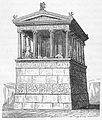Arbinas
| Arbinas | ||
|---|---|---|
 | ||
Arbinas, Erbinas o Erbbina era un gobernante licio que gobernó alrededor de los años 430/420 a 400 a. C., sometido al Imperio Aqueménida.[1] Es famoso por su tumba, el Monumento de las Nereidas, que se exhibe en el Museo Británico.[2] La numismática parece indicar que gobernó en la parte occidental de Licia, alrededor de Telmeso, mientras que su tumba está en Janto.[3]
Era hijo del anterior rey licio, llamado Kheriga.[4] En sus inscripciones, Erbinas se describe como un tirano, y como «el hombre que gobierna a los licios».[4]
Parece que el reino de Licia comenzó a desintegrarse durante el gobierno de Arbinas, ya que numerosos gobernantes más pequeños comenzaron a acuñar monedas en Licia durante su reinado y después de él.[1]
Tumba
[editar]Su tumba monumental, el Monumento de las Nereidas, actualmente en el Museo Británico, fue la principal inspiración para el famoso Mausoleo de Halicarnaso.[5] Usa el diseño de un templo griego, porque la construcción de una tumba era algo inaudito en la Grecia continental. Según Melanie Michailidis, a pesar de tener un «aspecto griego», el Monumento de las Nereidas y la Tumba de Payava se construyeron de acuerdo con criterios del zoroastrismo: fueron construidos con piedra fina, levantada sobre zócalos, y con cámaras simples sin ventana».[6]
-
Se cree que el Monumento de las Nereidas es la tumba de Arbinas. Museo Británico.
-
Reconstrucción del sepulcro original de Erbinas.
-
Retrato de Arbinas, con gorra persa. Monumento de las Nereidas.
-
AArbinas, en traje persa, recibe emisarios. Monumento de las Nereidas.
Monedas
[editar]-
Moneda del Rey Arbinas, luciendo la gorra persa en el reverso. Hacia 430/20-400 a. C.
-
Moneda del Rey Arbinas. Atenea y Heracles a cada lado. Hacia 430/20-400 a. C.
-
Moneda del Rey Arbinas. Atenea y Heracles.
Referencias
[editar]- ↑ a b Fried, Lisbeth S. (2004). The Priest and the Great King: Temple-palace Relations in the Persian Empire (en inglés). Eisenbrauns. p. 150. ISBN 9781575060903.
- ↑ Keen, Antony G. (1998). Dynastic Lycia: A Political of History of the Lycians and Their Relations with Foreign Powers: C. 545-362 B.C. (en inglés). Brill. p. 145. ISBN 9004109560.
- ↑ Keen, Antony G. (1998). Dynastic Lycia: A Political of History of the Lycians and Their Relations with Foreign Powers: C. 545-362 B.C. (en inglés). Brill. p. 146. ISBN 9004109560.
- ↑ a b Keen, Antony G. (1998). Dynastic Lycia: A Political of History of the Lycians and Their Relations with Foreign Powers: C. 545-362 B.C. (en inglés). Brill. p. 47. ISBN 9004109560.
- ↑ André-Salvini, Béatrice (2005). Forgotten Empire: The World of Ancient Persia (en inglés). University of California Press. p. 46. ISBN 9780520247314.
- ↑ Michailidis, Melanie (2009). «Empty Graves: The Tomb Towers of Northern Iran». En Gacek, Tomasz; Pstrusińska, Jadwiga, eds. Proceedings of the Ninth Conference of the European Society for Central Asian Studies. Cambridge Scholars Publishing. p. 253. ISBN 978-1443815024.
Text is available under the CC BY-SA 4.0 license; additional terms may apply.
Images, videos and audio are available under their respective licenses.







